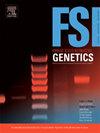利用细菌、真菌、植物和节肢动物的eDNA与模拟地质证据进行样本间比较和研究地点分离:一项可行性研究
IF 3.1
2区 医学
Q2 GENETICS & HEREDITY
引用次数: 0
摘要
土壤和灰尘通常作为地质证据提交给法医实验室,以便将个人与犯罪联系起来或确定样本来源。然而,尽管生物成分具有证据价值,但只有这些材料中的无机成分会被常规分析。来自土壤和灰尘等大宗来源的环境 DNA(eDNA)可通过 DNA 代谢编码来确定其特征,即利用新一代测序技术对基因组的短区域进行扩增和测序。对 eDNA 的法医分析研究主要针对从土壤中提取的细菌和真菌 DNA。在这项可行性研究中,我们试图确定细菌、真菌、植物和节肢动物的 DNA 单独或组合是否稳定,以便在研究地点之间进行样本间比较,而不受空间和时间变量以及模拟证据变化的影响。我们在美国北卡罗来纳州罗利的两个地点收集了模拟土壤和灰尘证据,为期一年。通过 DNA 代谢编码,我们发现:a)细菌、真菌和植物单独或组合可以区分土壤和灰尘模拟物证,也可以区分两个研究地点的模拟物证,因为分类群落存在显著差异;b)在一年的时间里,从植物中回收的 DNA 在灰尘模拟物证项目之间是一致的。一般来说,土壤中基因组 DNA 的总浓度明显高于粉尘,土壤分类群落的分类学多样性也高于粉尘分类群落。我们还发现了植物扩增过程中的偏差,这证明在 DNA 元条码分析中需要使用多对引物来捕捉样本中完整的分类多样性。这项研究的结果凸显了利用法医地质材料中的 eDNA 来补充法医地质检查的前景。本文章由计算机程序翻译,如有差异,请以英文原文为准。
Utilizing eDNA from bacteria, fungi, plants, and arthropods associated with mock geologic evidence for sample-to-sample comparisons and study site separation: A feasibility study
Soil and dust are commonly submitted to forensic laboratories as geologic evidence to either link an individual to a crime or to determine sample provenance. However, only the inorganic components within these materials are routinely analyzed despite evidentiary value of the biological components. Environmental DNA (eDNA) from bulk sources, such as soil and dust, can be characterized through DNA metabarcoding, where short regions of the genome are amplified and sequenced using next generation sequencing. Research on the forensic analysis of eDNA has largely been on bacterial and fungal DNA recovered from soil. In this feasibility study, we sought to determine whether DNA from bacteria, fungi, plants, and arthropods individually or in combination were stable to permit sample-to-sample comparisons between study sites regardless of spatial and temporal variables, as well as mock evidence variability. Mock soil and dust evidence was collected from two sites in Raleigh, NC (USA) over a one-year period. Using DNA metabarcoding we found that a) bacteria, fungi, and plants alone or in combination could differentiate between soil and dust mock evidence and between mock evidence from the two study sites, as the taxonomic communities were significantly different, and b) DNA recovered from plants were consistent between dust mock evidence items over the one year period. In general, total genomic DNA concentrations from soil were significantly higher compared to dust, and soil taxa were more taxonomically diverse compared to dust taxa. We also identified biases in amplification of plants, supporting the need of multiple primer pairs in DNA metabarcoding analyses to capture the full taxonomic diversity within samples. The results from this study highlight the promise of utilizing eDNA from forensic geologic materials to supplement forensic geology examinations.
求助全文
通过发布文献求助,成功后即可免费获取论文全文。
去求助
来源期刊
CiteScore
7.50
自引率
32.30%
发文量
132
审稿时长
11.3 weeks
期刊介绍:
Forensic Science International: Genetics is the premier journal in the field of Forensic Genetics. This branch of Forensic Science can be defined as the application of genetics to human and non-human material (in the sense of a science with the purpose of studying inherited characteristics for the analysis of inter- and intra-specific variations in populations) for the resolution of legal conflicts.
The scope of the journal includes:
Forensic applications of human polymorphism.
Testing of paternity and other family relationships, immigration cases, typing of biological stains and tissues from criminal casework, identification of human remains by DNA testing methodologies.
Description of human polymorphisms of forensic interest, with special interest in DNA polymorphisms.
Autosomal DNA polymorphisms, mini- and microsatellites (or short tandem repeats, STRs), single nucleotide polymorphisms (SNPs), X and Y chromosome polymorphisms, mtDNA polymorphisms, and any other type of DNA variation with potential forensic applications.
Non-human DNA polymorphisms for crime scene investigation.
Population genetics of human polymorphisms of forensic interest.
Population data, especially from DNA polymorphisms of interest for the solution of forensic problems.
DNA typing methodologies and strategies.
Biostatistical methods in forensic genetics.
Evaluation of DNA evidence in forensic problems (such as paternity or immigration cases, criminal casework, identification), classical and new statistical approaches.
Standards in forensic genetics.
Recommendations of regulatory bodies concerning methods, markers, interpretation or strategies or proposals for procedural or technical standards.
Quality control.
Quality control and quality assurance strategies, proficiency testing for DNA typing methodologies.
Criminal DNA databases.
Technical, legal and statistical issues.
General ethical and legal issues related to forensic genetics.

 求助内容:
求助内容: 应助结果提醒方式:
应助结果提醒方式:


